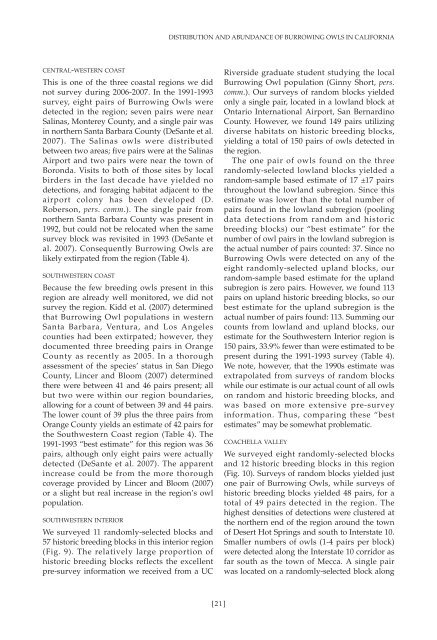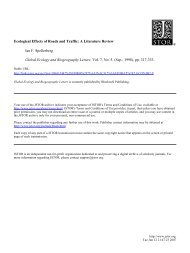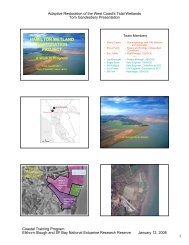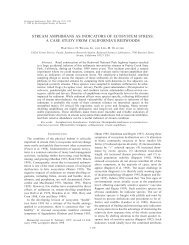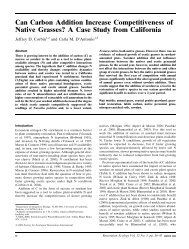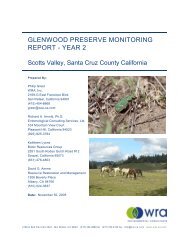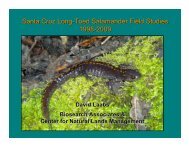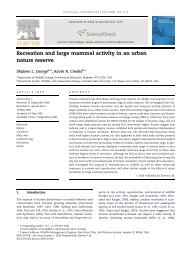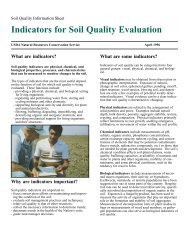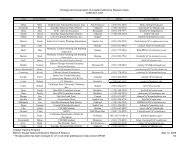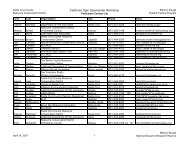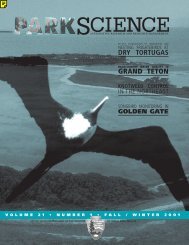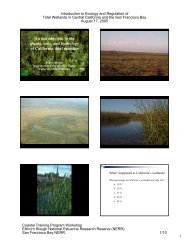BIRD POPULATIONS - Birdpop.org
BIRD POPULATIONS - Birdpop.org
BIRD POPULATIONS - Birdpop.org
- No tags were found...
You also want an ePaper? Increase the reach of your titles
YUMPU automatically turns print PDFs into web optimized ePapers that Google loves.
DISTRIBUTION AND ABUNDANCE OF BURROWING OWLS IN CALIFORNIACENTRAL-WESTERN COASTThis is one of the three coastal regions we didnot survey during 2006-2007. In the 1991-1993survey, eight pairs of Burrowing Owls weredetected in the region; seven pairs were nearSalinas, Monterey County, and a single pair wasin northern Santa Barbara County (DeSante et al.2007). The Salinas owls were distributedbetween two areas; five pairs were at the SalinasAirport and two pairs were near the town ofBoronda. Visits to both of those sites by localbirders in the last decade have yielded nodetections, and foraging habitat adjacent to theairport colony has been developed (D.Roberson, pers. comm.). The single pair fromnorthern Santa Barbara County was present in1992, but could not be relocated when the samesurvey block was revisited in 1993 (DeSante etal. 2007). Consequently Burrowing Owls arelikely extirpated from the region (Table 4).SOUTHWESTERN COASTBecause the few breeding owls present in thisregion are already well monitored, we did notsurvey the region. Kidd et al. (2007) determinedthat Burrowing Owl populations in westernSanta Barbara, Ventura, and Los Angelescounties had been extirpated; however, theydocumented three breeding pairs in OrangeCounty as recently as 2005. In a thoroughassessment of the species’ status in San DiegoCounty, Lincer and Bloom (2007) determinedthere were between 41 and 46 pairs present; allbut two were within our region boundaries,allowing for a count of between 39 and 44 pairs.The lower count of 39 plus the three pairs fromOrange County yields an estimate of 42 pairs forthe Southwestern Coast region (Table 4). The1991-1993 “best estimate” for this region was 36pairs, although only eight pairs were actuallydetected (DeSante et al. 2007). The apparentincrease could be from the more thoroughcoverage provided by Lincer and Bloom (2007)or a slight but real increase in the region’s owlpopulation.SOUTHWESTERN INTERIORWe surveyed 11 randomly-selected blocks and57 historic breeding blocks in this interior region(Fig. 9). The relatively large proportion ofhistoric breeding blocks reflects the excellentpre-survey information we received from a UCRiverside graduate student studying the localBurrowing Owl population (Ginny Short, pers.comm.). Our surveys of random blocks yieldedonly a single pair, located in a lowland block atOntario International Airport, San BernardinoCounty. However, we found 149 pairs utilizingdiverse habitats on historic breeding blocks,yielding a total of 150 pairs of owls detected inthe region.The one pair of owls found on the threerandomly-selected lowland blocks yielded arandom-sample based estimate of 17 ±17 pairsthroughout the lowland subregion. Since thisestimate was lower than the total number ofpairs found in the lowland subregion (poolingdata detections from random and historicbreeding blocks) our “best estimate” for thenumber of owl pairs in the lowland subregion isthe actual number of pairs counted: 37. Since noBurrowing Owls were detected on any of theeight randomly-selected upland blocks, ourrandom-sample based estimate for the uplandsubregion is zero pairs. However, we found 113pairs on upland historic breeding blocks, so ourbest estimate for the upland subregion is theactual number of pairs found: 113. Summing ourcounts from lowland and upland blocks, ourestimate for the Southwestern Interior region is150 pairs, 33.9% fewer than were estimated to bepresent during the 1991-1993 survey (Table 4).We note, however, that the 1990s estimate wasextrapolated from surveys of random blockswhile our estimate is our actual count of all owlson random and historic breeding blocks, andwas based on more extensive pre-surveyinformation. Thus, comparing these “bestestimates” may be somewhat problematic.COACHELLA VALLEYWe surveyed eight randomly-selected blocksand 12 historic breeding blocks in this region(Fig. 10). Surveys of random blocks yielded justone pair of Burrowing Owls, while surveys ofhistoric breeding blocks yielded 48 pairs, for atotal of 49 pairs detected in the region. Thehighest densities of detections were clustered atthe northern end of the region around the townof Desert Hot Springs and south to Interstate 10.Smaller numbers of owls (1-4 pairs per block)were detected along the Interstate 10 corridor asfar south as the town of Mecca. A single pairwas located on a randomly-selected block along[21]


